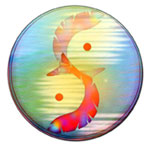On The Way: The Daily Zen Journal
Treatise on the Essentials of Cultivating the Mind Part 2
Hung-jen (early 8th century)
Question: Why is maintaining awareness of the mind the fundamental basis of nirvana?
Answer: The essence of what is called nirvana is serene extinction. It is unconditioned and pleasant. When one’s mind is True, false thoughts cease. When false thoughts cease, the result is correct mindfulness. Having correct mindfulness leads to the generation of the wisdom of serene illumination, which in turn means that one achieves total comprehension of the Dharma Nature. By comprehending the Dharma Nature, one achieves nirvana. Therefore, maintaining awareness of the mind is the fundamental basis of nirvana.
Question: Why is maintaining awareness of the mind the essential gateway for entering the path?
Answer: The Buddha teaches that even actions as seemingly trivial as raising the fingers of a single hand to draw an image of the Buddha can create merit as great as the sands of the River Ganges. However, this is just his way of enticing foolish sentient beings to create superior karmic conditions whereby they will see the Buddha and become enlightened in the future. If you wish to achieve buddhahood quickly in your own body, maintain awareness of the True Mind.
The Buddhas of the past, present, and future are incalculable and infinite in number, and every single one of them achieved buddhahood by maintaining awareness of the True Mind. Therefore, the sutra says: “When one fixes the mind in a single location, there is nothing it cannot accomplish.” Therefore, maintaining awareness of the True mind is the essential gateway for entering the path.
Question: Why is maintaining the True Mind the basic principle of the entire Buddhist canon?
Answer: Throughout the canon, the Tathagata preaches extensively about all types of transgression and good fortune, causes and conditions, and rewards and retributions. He also draws upon all the various things of this world, mountains, rivers, the earth, plants, trees, etc. to make innumerable metaphors. He also manifests innumerable supernormal powers and various kinds of transformations. All these are just the Buddha’s way of teaching foolish sentient beings. Since they have various kinds of desires and a myriad of psychological differences, the Tathagata draws them into permanent bliss according to their mental tendencies.
Understand clearly that the Buddha Nature embodied within sentient beings is inherently pure, like a sun underlaid by clouds. By just distinctly maintaining awareness of the True Mind, the clouds of false thoughts will go away, and the sun of wisdom will appear. Why make any further study of knowledge based on the senses, which only leads to the suffering of samsara?
All concepts, as well as affairs of the three periods of time, should be understood according to the metaphor of polishing a mirror: When the dust is gone the Nature naturally becomes manifest. That which is learned by the ignorant mind is completely useless. True learning is that which is learned by the inactive or unconditioned, wu wei mind, which never ceases correct mindfulness. Although this is called “true learning,” ultimately there is nothing to be learned. Why is this?

Because the self and nirvana are both nonsubstantial, they are neither different nor the same. Therefore, the essential principle of the words “nothing to be learned” is true.
One must maintain clear awareness of the True Mind without generating false thoughts or the illusion of personal possession. Therefore, the Nirvana Sutra says: “To understand that the Buddha does not actually preach the Dharma is called having sufficiently listened to the Buddha’s preaching.” Therefore, maintaining awareness of the True Mind is the basic principle of the entire canon.
Question: Why is maintaining awareness of the mind the patriarch of all the Buddhas past, present, and future?
Answer: All the Buddhas of the past, present, and future are generated within one’s own consciousness. When you do not generate false thoughts, the Buddhas are generated within your consciousness. When your illusions of personal possession have been extinguished, the Buddhas are generated within your consciousness. You will only achieve buddhahood by maintaining awareness of the True Mind. Therefore, maintaining awarenss of the mind is the patriarch of the all the Buddhas of past, present, and future.
If one were to expand upon the four previous topics, how could one ever explain them completely? My only desire is that you discern the fundamental mind for yourselves. Therefore, I sincerely tell you: Make effort! Make effort!
Hung-jen (early 8th c)
Excerpted from The Northern School and the Formation of Early Ch’an Buddhism by John R. McRae 1986




This chapter from early in the history of Ch’an continues the dialogue with Master Hung-jen from around the year 700. In this section we learn more about his teaching of True Mind and also get a taste of his insights into meditation practice. The comments still leave us free to explore without anyone telling us too much about what to get out of our explorations.
These readings are born from a spirit of commitment to the Way. Hopefully Hung-jen will help us to pause and allow some new opening to reveal itself in our lives.
Wandering
My treasure is the cloud on the peak
The moon over the valley
Traveling east or west
Light and free on the one road
I don’t know whether I’m on the way
Or at home.
-Muso Soseki (1275-1351)
Which way
Did you come from,
Following dream paths at night,
While snow is still deep
In this mountain recess?
– Ryokan (1758-1831)
Honoring the Solstice in both hemispheres,
Elana